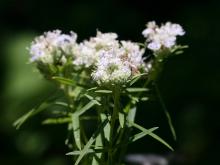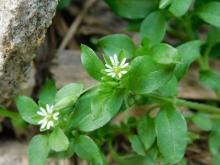Wildflowers, Grasses and Other Nonwoody Plants
Media

Species Types
Scientific Name
Allium stellatum
Description
Wild onion is edible and is also favored by native-plant gardeners, who enjoy its showy umbels of pink flowers and tolerance of dry, rocky sites. This Ozark species blooms in summer and fall.
Media

Species Types
Scientific Name
Polygonatum biflorum
Description
Solomon's seal grows statewide in moist, rich earth. The greenish-white flowers dangle like little bells beneath the leaves, under the gracefully arching stems.
Media

Species Types
Scientific Name
Tradescantia ohiensis
Description
Smooth spiderwort is the most common and widely distributed of Missouri's spiderworts. It has slender, straight or zigzag stems. The long, narrow leaves are folded lengthwise and attach to the stem in a thick node. The 3 petals of the triangular flower are blue, rose, purple, lavender, or white.
Media

Species Types
Scientific Name
Monarda bradburiana (sometimes M. russeliana)
Description
Also called horsemint and wild bergamot, Bradbury beebalm is a showy, fragrant plant that is a favorite of native plant gardeners. It’s also a favorite of Missouri’s butterflies!
Media

Species Types
Scientific Name
Pycnanthemum tenuifolium
Description
Slender mountain mint has smooth, square stems, opposite, narrow leaves, and dense heads of 2-lipped white (or lavender) flowers. Aromatic and minty, it can be grown at home in the herb garden, and its leaves used for seasoning food.
Media

Species Types
Scientific Name
Stellaria media
Description
Common chickweed, native to Europe, has been introduced nearly worldwide and is a familiar garden weed in Missouri. It forms spreading mats on the ground and has small flowers with 5 petals, each deeply lobed making it look like 10.
See Also
About Wildflowers, Grasses and Other Nonwoody Plants in Missouri
A very simple way of thinking about the green world is to divide the vascular plants into two groups: woody and nonwoody (or herbaceous). But this is an artificial division; many plant families include some species that are woody and some that are not. The diversity of nonwoody vascular plants is staggering! Think of all the ferns, grasses, sedges, lilies, peas, sunflowers, nightshades, milkweeds, mustards, mints, and mallows — weeds and wildflowers — and many more!





















